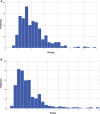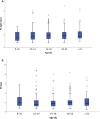Low false-positive rate of perfusion index as a screening tool for neonatal aortic coarctation
- PMID: 33170979
- PMCID: PMC8246534
- DOI: 10.1111/apa.15661
Low false-positive rate of perfusion index as a screening tool for neonatal aortic coarctation
Abstract
Aim: Adding perfusion index (PI) to pulse oximetry screening (POS) may increase neonatal detection of CoA (aortic coarctation). A cut-off <0.7% has been suggested but is associated with a high rate of false positives. We aimed to evaluate the specificity of PI when using repeated instead of single measurements.
Methods: A pilot study was conducted in 50 neonates. PI was recorded in right hand and a foot by pulse oximeter. If PI was <0.7%, the measurement was immediately repeated up to 3 times. If all three measurements were <0.7% in hand and/or foot the screen was positive and echocardiography was performed. There were 3/50 false-positive screens. The protocol was therefore modified requiring 30 min intervals between measurements.
Results: An additional 463 neonates were included using the modified protocol at a median age of 18 h. There were no false positives. The only neonate with CoA had a negative screen (PI hand 1.2% and foot 0.8%). The measurement required on average an extra 3 min and 30 s compared with POS only.
Conclusion: The false-positive rate of PI was reduced by using repeated PI measurements. The sensitivity for CoA using this protocol should be evaluated in large-scale prospective studies.
Keywords: aortic coarctation; perfusion index; screening.
© 2020 The Authors. Acta Paediatrica published by John Wiley & Sons Ltd on behalf of Foundation Acta Paediatrica.
Conflict of interest statement
The authors have no conflicts of interest relevant to this article to disclose.
Figures




References
-
- Hoffman JIE, Kaplan S. The incidence of congenital heart disease. J Am Coll Cardiol. 2002;39(12):1890‐1900. - PubMed
-
- Chang R‐KR, Gurvitz M, Rodriguez S. Missed diagnosis of critical congenital heart disease. Arch Pediatr Adolesc Med. 2008;162(10):969‐974. - PubMed
-
- Wren C, Reinhardt Z, Khawaja K. Twenty‐year trends in diagnosis of life‐threatening neonatal cardiovascular malformations. Arch Dis Child Fetal Neonatal Ed. 2008;93(1):F33‐F35. - PubMed
Publication types
MeSH terms
LinkOut - more resources
Full Text Sources
Medical
Research Materials
Miscellaneous

